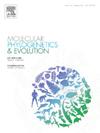系统基因组学揭示了渐新世-中新世过渡时期,气候驱动的蚁族Megistopini(神经翅目:Myrmeleontidae: Nemoleontinae)的范围扩张。
IF 3.6
1区 生物学
Q2 BIOCHEMISTRY & MOLECULAR BIOLOGY
引用次数: 0
摘要
麻蛉科(蚁蛉和猫头鹰蛉)是麻蛉目(草蛉)中种类最丰富的科,但其高级分类和进化历史尚未得到全面的研究。本文基于超保守元素(UCE)数据,对蚁狮部落Megistopini进行了全面的分子系统发育和生物地理分析。蚁狮部落Megistopini是一个鲜为人知的群体,没有众所周知的陷阱建造幼虫行为,主要居住在沙子或岩石碎屑中。Megistopini的单系性得到了强有力的支持,包括一些以前被认为是Nemoleontini成员的属,即Indoleon Banks, 1913, Negrokus Navás, 1930, Paraglenurus van der Weele, 1909, thaumateon Esben-Petersen, 1921,和Yunleon Yang, 1986。通过分子分析也证实了gymnonemia Schneider, 1845, Nedroledon Navás, 1914属于Megistopini。我们建立了一个新的属,喜马拉雅山gen. n.,以容纳一些被分类为inintertae sedis在Nemoleontinae的物种,即H. binatus (Yang, 1987) comb。n., H. cancellosus (Yang, 1987)梳子。n.,和H. vartianorum (Hölzel, 1972)梳子。n.生物地理学研究表明,Megistopini可能起源于中渐新世的扎格罗斯-伊朗高原-喜马拉雅-横断山脉。后来,青藏高原的隆升以及周围的造山运动和气候变化导致了中新世Megistopini的辐射,并在欧亚大陆传播。此外,我们的研究结果表明,对跖前爪的存在是细长腿蚁的一个共同特征,是Megistopini的祖先状态,在某些属中是次要丢失的,也与栖息地选择无关。本文章由计算机程序翻译,如有差异,请以英文原文为准。

Phylogenomics reveals climate-driven range expansion of the antlion tribe Megistopini (Neuroptera: Myrmeleontidae: Nemoleontinae) during the Oligocene-Miocene transition
Myrmeleontidae (antlions and owlflies) represents the most diverse family of Neuroptera (lacewings), while the higher-level classification and evolutionary history has yet been investigated comprehensively. Here we present a comprehensive molecular phylogenetic and biogeographic analysis of the antlion tribe Megistopini, a poorly known group without the well-known pitfall-building larval behavior but primarily inhabiting sand or rock debris, based on Ultraconserved Elements (UCE) data. The monophyly of Megistopini was strongly supported, comprising some genera previously considered as members of Nemoleontini, i.e., Indoleon Banks, 1913, Negrokus Navás, 1930, Paraglenurus van der Weele, 1909, Thaumatoleon Esben-Petersen, 1921, and Yunleon Yang, 1986. The attribution of Gymnocnemia Schneider, 1845, Nedroledon Navás, 1914 to Megistopini was also confirmed by the molecular analysis. We establish a new genus Himaleon gen. n. to accommodate some species that are classified as incertae sedis within Nemoleontinae, i.e., H. binatus (Yang, 1987) comb. n., H. cancellosus (Yang, 1987) comb. n., and H. vartianorum (Hölzel, 1972) comb. n. Our biogeographic study suggests that Megistopini likely originated in the Zagros-Iranian Plateau-Himalayas-Hengduan Mountains during the mid-Oligocene. Later, the uplift of the Qinghai-Xizang Plateau, along with the surrounding orogenic movements and climatic changes, led to a radiation of Megistopini during the Miocene, which spread in Eurasia. Moreover, our results suggest that the presence of opposable pretarsal claw, a common character in slender-legged antlions, is the ancestral state of Megistopini and was secondarily lost in some genera, also not appearing correlated to habitat choice.
求助全文
通过发布文献求助,成功后即可免费获取论文全文。
去求助
来源期刊
CiteScore
7.50
自引率
7.30%
发文量
249
审稿时长
7.5 months
期刊介绍:
Molecular Phylogenetics and Evolution is dedicated to bringing Darwin''s dream within grasp - to "have fairly true genealogical trees of each great kingdom of Nature." The journal provides a forum for molecular studies that advance our understanding of phylogeny and evolution, further the development of phylogenetically more accurate taxonomic classifications, and ultimately bring a unified classification for all the ramifying lines of life. Phylogeographic studies will be considered for publication if they offer EXCEPTIONAL theoretical or empirical advances.

 求助内容:
求助内容: 应助结果提醒方式:
应助结果提醒方式:


